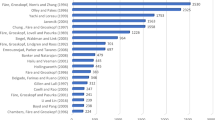Abstract
The Malmquist productivity index is not transitive. This paper argues that, instead of trying to accommodate this two-period concept to a multi-period setting, it is preferable to look at the measurement of productivity, efficiency, and technical change in a multi-period setting from the outset. A new, transitive productivity index is developed with as by-product a measure of the non-neutrality of technical change. The various indices are illustrated on panel data of Swedish pharmacies.
Similar content being viewed by others
References
Aczél, J. (1990). “Determining Merged Relative Scores”. Journal of Mathematical Analysis and Applications, 150, 20–40.
Althin, R (1995). “Measurement of Productivity Changes: Two Malmquist Index Approaches”. In Essays on the Measurement of Producer Performance. Doctoral Dissertation, Department of Economics, University of Lund.
Balk, B.M. (1996). “Multilateral Methods for International Price and Volume Comparisons”. Journal of Official Statistics, to appear.
Balk, B.M. (1995). “Axiomatic Price Index Theory: A Survey”. International Statistical Review 63, 69–93.
Berg, S.A., F.R. Førsund, and E.S. Jansen. (1992). “Malmquist Indices of Productivity Growth during the Deregulation of Norwegian Banking, 1980–89”. Scandinavian Journal of Economics 94, Supplement, 211–228.
Bjurek, H., and L. Hjalmarsson. (1995). “Productivity in Multiple Output Public Service: A Quadratic Frontier Function and Malmquist Index Approach”. Journal of Public Economics 56, 447–460.
Caves, D.W., L.R. Christensen, and W.E. Diewert. (1982a). “The Economic Theory of Index Numbers and the Measurement of Input, Output and Productivity”, Econometrica 50, 1393–1414.
Caves, D.W., L.R. Christensen, and W.E. Diewert. (1982b). “Multilateral Comparisons of Output, Input, and Productivity Using Superlative Index Numbers”. The Economic Journal 92, 73–86.
Eltetö, O., and P. Köves. (1964). “On an Index Computation Problem in International Comparisons” (in Hungarian). Statistikai Szemle 42, 507–518.
Färe, R. (1993). “The Malmquist Productivity Index and the Circular Test”. Unpublished working paper, CORE, Leuven.
Färe, R., and S. Grosskopf. (1994). Malmquist Productivity Indexes and Biased Technical Change. Discussion Paper No. 94–03, Department of Economics, Southern Illinois University, Carbondale.
Färe, R., S. Grosskopf, B. Lindgren, and P. Roos. (1989). Productivity Developments in Swedish Hospitals: A Malmquist Output Index Approach. Discussion Paper No. 89–3, Department of Economics, Southern Illinois University, Carbondale. Chapter 13 in A. Charnes, W.W. Cooper, A.Y. Lewin, and L.R. Seiford (eds.), Data Envelopment Analysis: Theory, Methodology, and Application. Boston/Dordrecht/London: Kluwer Academic Publishers, 1994.
Färe, R., S. Grosskopf, B. Lindgren, and P. Roos. (1992). “Productivity Changes in Swedish Pharmacies 1980–1989: A Non-Parametric Approach”. The Journal of Productivity Analysis 3, 85–101.
Färe, R., S. Grosskopf, M. Norris, and Z. Zhang. (1994). “Productivity Growth, Technical Progress, and Efficiency Change in Industrialized Countries”. The American Economic Review 84, 66–83.
Färe, R. and D. Primont. (1995). Multi-Output Production and Duality: Theory and Applications. Dordrecht: Kluwer Academic Publishers.
Grifell-Tatjé, E., and C.A.K. Lovell. (1994). A New Decomposition of the Malmquist Productivity Index. Working Paper No. 94–392E, College of Business Administration, The University of Georgia, Athens.
Rao, D.S.P., and K.S. Banerjee. (1986). “A Multilateral Index Number System Based on the Factorial Approach”. Statistische Hefte/Statistical Papers 27, 297–313.
Szulc, B. (1964). “Index Numbers of Multilateral Regional Comparisons” (in Polish). Przeglad Statysticzny 3, 239–254.
Westergaard, H. (1890). Die Grundzüge der Theorie der Statistik. Jena: Gustav Fischer.
Author information
Authors and Affiliations
Additional information
At the time of writing, R. Althin was employed by The Swedish Institute for Health Economics. The views expressed in this paper are those of the authors and do not necessarily reflect the policies of Statistics Netherlands or The Swedish Institute for Health Economics.
Rights and permissions
About this article
Cite this article
Balk, B.M., Althin, R. A new, transitive productivity index. J Prod Anal 7, 19–27 (1996). https://doi.org/10.1007/BF00158474
Issue Date:
DOI: https://doi.org/10.1007/BF00158474




